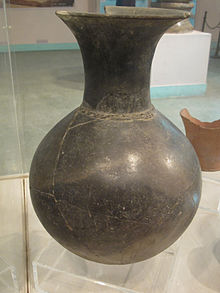
Back বুরজাহোম প্রত্নক্ষেত্র Bengali/Bangla Burzahom German बुर्ज़होम HI Burzahom Dutch ବୁର୍ଜାମ ପ୍ରତ୍ନତାତ୍ତ୍ୱିକ ସ୍ଥଳ OR
 A pot excavated from Burzahom | |
| Location | Srinagar, Jammu and Kashmir, India |
|---|---|
| Coordinates | 34°10′12″N 74°52′01″E / 34.169883°N 74.866841°E |
| Type | Pre-historic Settlement |
| History | |
| Periods | Neolithic, Megalithic and early Historic period. |
| Site notes | |
| Excavation dates | 1939 and from 1960 to 1971 |
| Archaeologists | de Terra and Paterson of Yale-Cambridge Expedition in 1939 and T.N. Khazanchi and his team of ASI from 1960 and 1971 |
The Burzahom archaeological site is located in the Srinagar district of the Kashmir Valley of Jammu and Kashmir, India. Evidences of wheat were found.[1] Archaeological excavations have revealed four phases of cultural significance between 3000 BCE and 1000 BCE.[2] Periods I and II represent the Neolithic era; Period III the Megalithic era (of massive stone menhirs and wheel turned red pottery); and Period IV relates to the early Historical Period (Post-megalithic period). The findings, recorded in stratified cultural deposits representing prehistoric human activity in Kashmir, are based on detailed investigations that cover all aspects of the physical evidence of the site, including the ancient flora and fauna.
The Burzahom site revealed the transition from the subterranean and ground level housing features of the Neolithic people to the mudbrick structures of the Megalithic people. The large cache of tools and implements made of bone and stone found at the site shows that the inhabitants were hunting and farming.
The unearthed Antiquities (of art, architecture, customs and rituals) indicate that the prehistoric people of the Burzahom established contact with Central Asia and South West Asia and also had links to the Gangetic plains and peninsular India. The interaction of local and foreign influences is demonstrated by the art, architecture, customs, rituals and language demonstrated by some engravings on pottery and other artifacts..
- ^ Jameel, Yusuf (9 April 2017). "Kashmir Valley monuments cry for care". The Asian Age. Retrieved 14 February 2021.
- ^ Dutta, Sweta (25 June 2017). "ASI report says even Neolithic Kashmir had textile industry". India Today. Archived from the original on 30 October 2020. Retrieved 14 February 2021.

